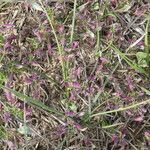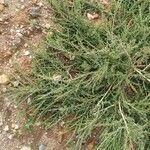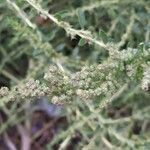Monoecious; bushy-branched, to 1 m high and wide, the stems whitish; lvs of flowering branches elliptic to oblong or obovate, 0.5–3 mm, pale green, obtuse or rounded, attenuate to a long petiole; early lvs often to 8 cm; fls in short, dense, axillary clusters; bracts rigid, subulate, 2–3 times as long as the fls; sep 3, with simple midvein, those of the pistillate fls straight, acutish, unequal, the longest nearly equaling the fr; stamens 3; style-branches very short, erect; fr lenticular, 1.3–1.7 mm, rugulose when dry, circumscissile at the middle; seed suborbicular, 0.7–1 mm; 2n=32. Fields and waste ground; native to the prairies and plains of c. N. Amer., now a weed throughout our range and elsewhere. (A. graecizans, misapplied)
Erect, much-branched, annual glabrous or glabrate herb to c. 50 cm high. Branches whitish, divaricate to ascending, angular. Lvs shortly petiolate, or petiole to 1.5 cm long. Lamina (3)-5-20-(30) × (1)-2-10-(15) mm, elliptic-obovate or nearly so; veins prominently raised below; margin undulate; base narrow-cuneate or attenuate; apex obtuse to rounded and mucronate. Infl. green, an axillary cluster of few fls, occurring in nearly all lf axils. Bracteoles 3-4.5 mm long, lanceolate-subulate, spine-tipped, prominently folded and keeled. Tepals (2)-3, 1-1.3 mm long, oblong to lanceolate. Fr. broadly ellipsoid to subglobular, from < to > tepals, circumscissile around the middle, slightly rugose. Seed c. 1 mm diam., globular, dark brown.
Stem erect or ascending, greenish white, 30-50 cm tall, branched from base, glabrous or strigose. Petiole 3-5 mm, glabrous; leaf blade obovate or spatulate, 0.5-2 cm, glabrous, base narrowing to petiole, margin slightly undulate, apex obtuse or notched, with a mucro. Flowers in axillary clusters or short terminal spikes. Bracts and bracteoles subulate, 2-2.5 mm, slightly rigid, apex acute. Tepals ca. 1 mm, shorter than bracts, membranous; male flowers oblong, apex acuminate; female ones oblong or subulate, apex short acuminate. Stamens longer than perianth; stigmas 3. Utricles brownish black, obovate, 1.2-1.5 mm, rugose, circumscissile. Seeds black to brownish black, subglobose, ca. 1 mm in diam. Fl. Jul-Aug, fr. Sep. 2n = 32.
An annual herb which grows to 1 m high. It can be erect or spreading. The leaves are alternate and sword shaped. They are 3 cm long. The flowers are green. The flower stalks are leafy to the top. The seeds are 1 mm across.










